How to Train an Adventure Puppy
I made a huge mistake at the beginning with my new puppy, Bodie. I fell into the very common trap of expecting my third Australian Shepherd to be like my other two. I thought he was going to be an easy dog to mold into what I wanted him to be. After all, I was two for two with Riley and Kona, they were both fairly easy puppies for their breed since neither showed a lot of desire to herd things. But Bodie is so different! He is more of a typical Aussie with a LOT of herding instincts. He’s highly reactive to anything that moves: kids, balls, other dogs, bikes – if it moves, he wants to control it!
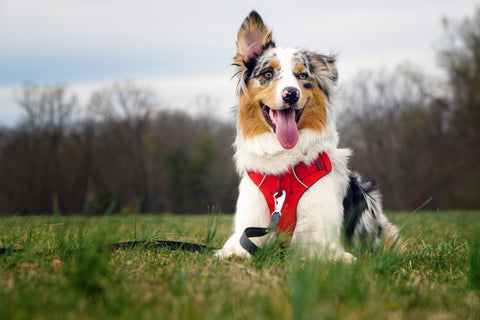
Photos Contributed by Ruffwear Ambassador Maria Christina Schultz
Another challenging character trait of Bodie’s is his love of people and children. He loves them so much that everyone is greeted with an exuberance that’s over the top. And by over the top, I mean he literally jumps up to eye level when greeting new people. He also clears fences, baby gates, and any other obstacle that comes between him and a shiny new creature. Managing Bodie’s excitement is a test of patience, and trying to be more engaging than whatever has caught his eye. Sorry, Bodie – you can’t herd kids!
Having an adventure dog means Bodie needs to ignore distractions we come across on the trails and in the water. The good news is, we still have time. Running, mountain biking, and long off leash hikes are out of the picture until Bodie is 18 months old. His growth plates need to close, and his ligaments and tendons need to strengthen before we can safely enjoy big adventures together. So, I still have 10 months to help Bodie quiet his instincts and develop the trail etiquette I know he’s capable of.
My plan for Bodie involves constant positive reinforcement, lots of play, bonding, and games to show him that working with me can be just as fulfilling as herding creatures. Of course, this plan includes some important tools of the trade – here’s a peek inside my training plan and the tools that are getting the job done:
Training Walks
Tools: The Front Range Harness & Leash, Treat Trader
Walking politely on a leash is vital for hiking adventures because it keeps us both safe. Pulling and lunging is unacceptable, especially on rocky forest trails, and even more so on steep terrain. I’m not a strict obedience trainer, I’m perfectly fine if my dog prefers to walk on my right, my left, or even in front of me – all I ask for is no tension on the leash. If Bodie starts pulling toward something, I give him a “with me” command and we walk the other way. I don’t allow him to interact with the object, person, or dog he’s pulling towards, because that would simply reward the pulling. Instead I reward him with praise and treats when he obliges and is walking nicely at my side.
I’ve found the best no-pull training tool is the Front Range Harness. Dogs that pull on collars can damage their trachea, while other no-pull harnesses restrict shoulder movement. The chest attachment point on the Front Range Harness is a safe way that allows Bodie to walk unrestricted with a reminder that pulling only directs him back to me. While Bodie is far from perfectly behaved on the leash, I’m very pleased with his progress considering his age and exuberance. He pulls dramatically less than Riley or Kona ever did, and this is a skill we work on several times a day.
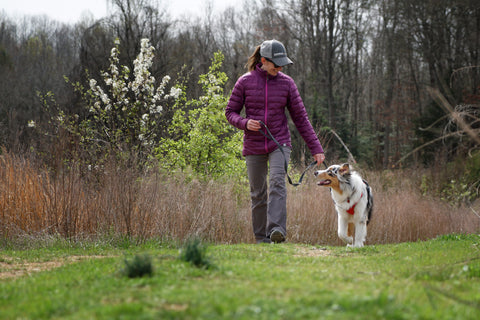
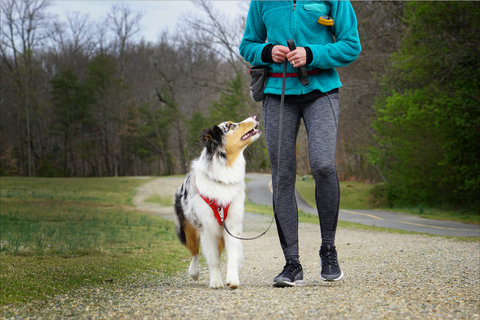
Play Time is also Training Time
Tools: Two Hydro Planes
The act of chasing down a moving object and snatching it is incredibly satisfying for dogs. Bodie has no shortage of prey drive so this game is super fun for him. This is something I do to help teach impulse control, recall, and drop it.
Here’s how it works: Bodie and I head out with two Hydro Planes. I get him really pumped up, then I ask him to sit and wait. Once Bodie has collected himself I release him and toss a Hydro Plane. He catches it, and usually starts running circles with it, so I immediately show him the one I still have in my hand, while saying “Bodie come!” It never fails, dogs always want the toy in your hand! So Bodie runs back to me, and as he gets close, I say “drop it,” when he does, I reward him by immediately throwing the second toy. Then I pick up the first Hydro Plane and we start all over again. This teaches Bodie that coming when called means fun and that we get to keep playing. He naturally drops one toy for the other, and learns the drop it cue in the process. Sometimes I mix things up and ask him to sit or down before I toss the toy again to work on impulse control.
In the last few weeks we’ve graduated to playing with just one Hydro Plane. Bodie has quickly discovered the reward is the game, so he comes back to me after each catch and quickly drops it for another toss. Most of the time he sits without me even having to ask for it! It’s fun to see him light up when we work together and I can feel our bond growing as we play together.
Note: Since Bodie is still growing this is something we only do a few times a week for very short sessions. I also keep my tosses low so he doesn’t have to leap into the air. Jumping is hard on a puppy’s joints - it’s really important we don’t injure anything before his growth plates close.
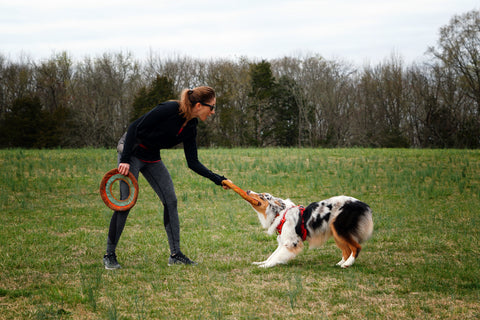
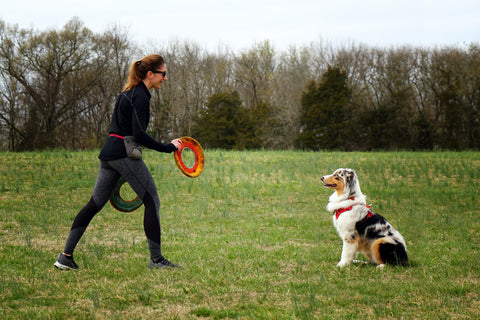
Building Toy Drive and Bonding
Tools: Pacific Loop
I love that Bodie is food motivated – it’s so much easier to train a dog who wants to work for food than one who doesn’t. But with Bodie I want to be more than a treat dispenser! I want him to value playing with me as much as his love for beef liver. Enter the Pacific Loop. This is a special reward that I have been using as a reward since Bodie was tiny. When I’m working with him I’ll mix things up between food rewards and play rewards.
Here’s what it looks like: I ask Bodie for about five behaviors I know he knows. After the fifth behavior he’ll get a big reward, a play session! This says to Bodie – “like everything you just did, isn’t it fun? Want to keep going?!” It keeps him excited to work, and it’s also super fun for me.
I also pull out the Pacific Loop (usually kept hidden inside my jacket) when he has a breakthrough. When we’re walking and we pass a dog and Bodie doesn’t react, I immediately pull out the Pacific Loop and we play tug. It’s a super high-value reward for the behavior I’m encouraging!
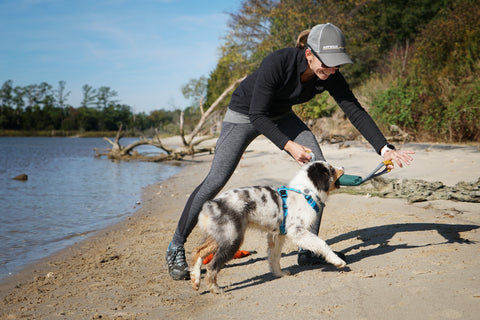
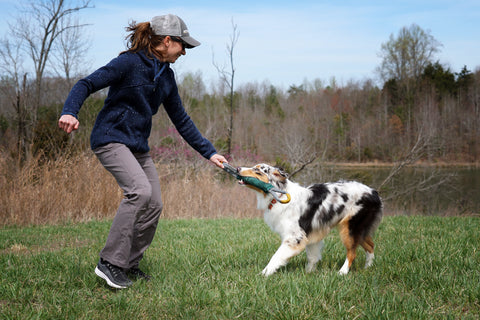
Training a dog is an adventure all on its own. The journey is long but the view at the end is a smiling dog with a spark in his eye that says “you are my whole world." This is always worth every setback, every mistake, and every puppy tantrum. As I write this at Bodie’s 9-month mark, I know I still have a long way to go, but I’m excited with his progress so far. This is a journey we’re on together – herding instincts and all, he’s going to be an amazing adventure buddy!

























